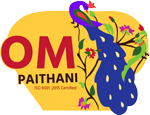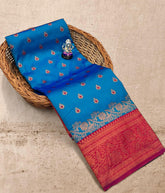India, a land renowned for its rich cultural heritage, boasts a myriad of traditional arts and crafts that are symbolic of its deep-rooted history. Among these treasures, Paithani sarees in Mumbai stand as a timeless testament to the country’s legacy of exquisite craftsmanship and
artistry. Adored for their intricate designs, vibrant colors, and historical significance, Paithani sarees hold a special place in Indian culture.
Origin and Legacy of Paithani Sarees
The roots of Paithani sarees trace back to the town of Paithan in Maharashtra, India. These sarees are steeped in history, believed to have originated more than two thousand years ago during the Satavahana era. Initially, they were exclusive to royalty and were considered a
symbol of prestige and wealth.
Craftsmanship and Unique Features
What distinguishes pure Paithani sarees in Mumbai is their distinctive weaving technique and the use of lustrous silk and opulent zari (metallic thread). One of the most remarkable aspects of these sarees is the peacock and lotus motifs woven with precision, making them a true work of art. The interlacing of gold and silver threads creates a luxurious texture, adding to the saree’s opulence.
Intricate Weaving Process
Paithani sarees are handwoven, a meticulous and time-consuming process that involves skillful artisans who pass down their craftsmanship through generations. The traditional loom used for weaving allows for the intricate incorporation of vibrant colors and complex designs, resulting in the breathtaking beauty of each saree.
Variety and Significance
Paithani sarees come in various types, such as “Kadiyal,” known for its double-sided zari border, and “Ratan Paithani,” recognized for its metallic and silk blend. These sarees often carry historical and cultural significance, with certain motifs and patterns representing aspects of nature, mythological stories, or religious symbols.
Celebrated across Generations and Occasions
Paithani sarees in Mumbai have remained a popular choice among Indian women for centuries. They are not just garments; they are symbols of tradition and grace. From wedding to cultural events, these sarees are cherished heirlooms passed down from mothers to daughters, representing heritage and timeless elegance.

Preserving Tradition in Modern Times
In contemporary India, the allure of Paithani sarees persists. While retaining their traditional charm, modern designers and weavers are innovating to cater to evolving tastes. Contemporary Paithani sarees explore new color combinations, designs, and patterns, appealing to a broader audience without compromising the essence of this traditional attire.
Promoting Artisanal Crafts
The appreciation for pure Paithani sarees in Mumbai goes beyond their aesthetic appeal.Supporting the creation and purchase of these sarees not only sustains a rich tradition but also empowers skilled artisans and weavers, contributing to the preservation of India’s cultural heritage.

Conclusion
Paithani sarees epitomize the cultural richness and artistic finesse of India. Their timeless beauty, intricate weaving, and historical significance make them an integral part of Indian heritage. Embraced for generations, these sarees continue to enchant with their elegance, transcending time and trends.
By celebrating and promoting Paithani sarees, we not only honor India’s glorious past but alone sure the survival of a craft that embodies the soul of the country. These sarees are not just garments; they are a legacy, a living embodiment of tradition, grace, and artistry, contributing to
the vibrant tapestry of Indian culture.








